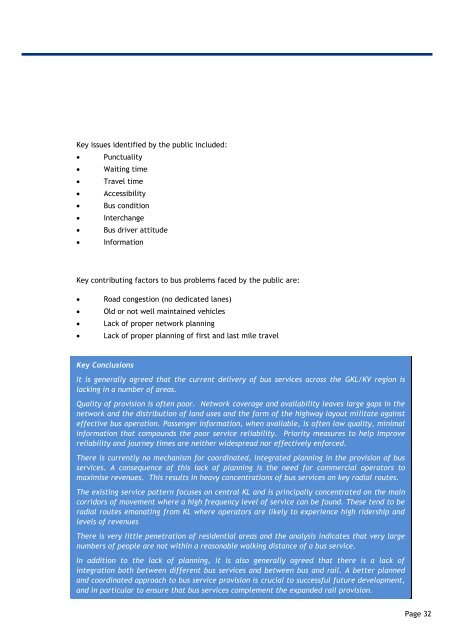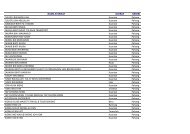Contents - SPAD
Contents - SPAD
Contents - SPAD
Create successful ePaper yourself
Turn your PDF publications into a flip-book with our unique Google optimized e-Paper software.
Key issues identified by the public included:<br />
Punctuality<br />
Waiting time<br />
Travel time<br />
Accessibility<br />
Bus condition<br />
Interchange<br />
Bus driver attitude<br />
Information<br />
Key contributing factors to bus problems faced by the public are:<br />
<br />
<br />
<br />
<br />
Road congestion (no dedicated lanes)<br />
Old or not well maintained vehicles<br />
Lack of proper network planning<br />
Lack of proper planning of first and last mile travel<br />
Key Conclusions<br />
It is generally agreed that the current delivery of bus services across the GKL/KV region is<br />
lacking in a number of areas.<br />
Quality of provision is often poor. Network coverage and availability leaves large gaps in the<br />
network and the distribution of land uses and the form of the highway layout militate against<br />
effective bus operation. Passenger information, when available, is often low quality, minimal<br />
information that compounds the poor service reliability. Priority measures to help improve<br />
reliability and journey times are neither widespread nor effectively enforced.<br />
There is currently no mechanism for coordinated, integrated planning in the provision of bus<br />
services. A consequence of this lack of planning is the need for commercial operators to<br />
maximise revenues. This results in heavy concentrations of bus services on key radial routes.<br />
The existing service pattern focuses on central KL and is principally concentrated on the main<br />
corridors of movement where a high frequency level of service can be found. These tend to be<br />
radial routes emanating from KL where operators are likely to experience high ridership and<br />
levels of revenues<br />
There is very little penetration of residential areas and the analysis indicates that very large<br />
numbers of people are not within a reasonable walking distance of a bus service.<br />
In addition to the lack of planning, it is also generally agreed that there is a lack of<br />
integration both between different bus services and between bus and rail. A better planned<br />
and coordinated approach to bus service provision is crucial to successful future development,<br />
and in particular to ensure that bus services complement the expanded rail provision.<br />
Page 32

















